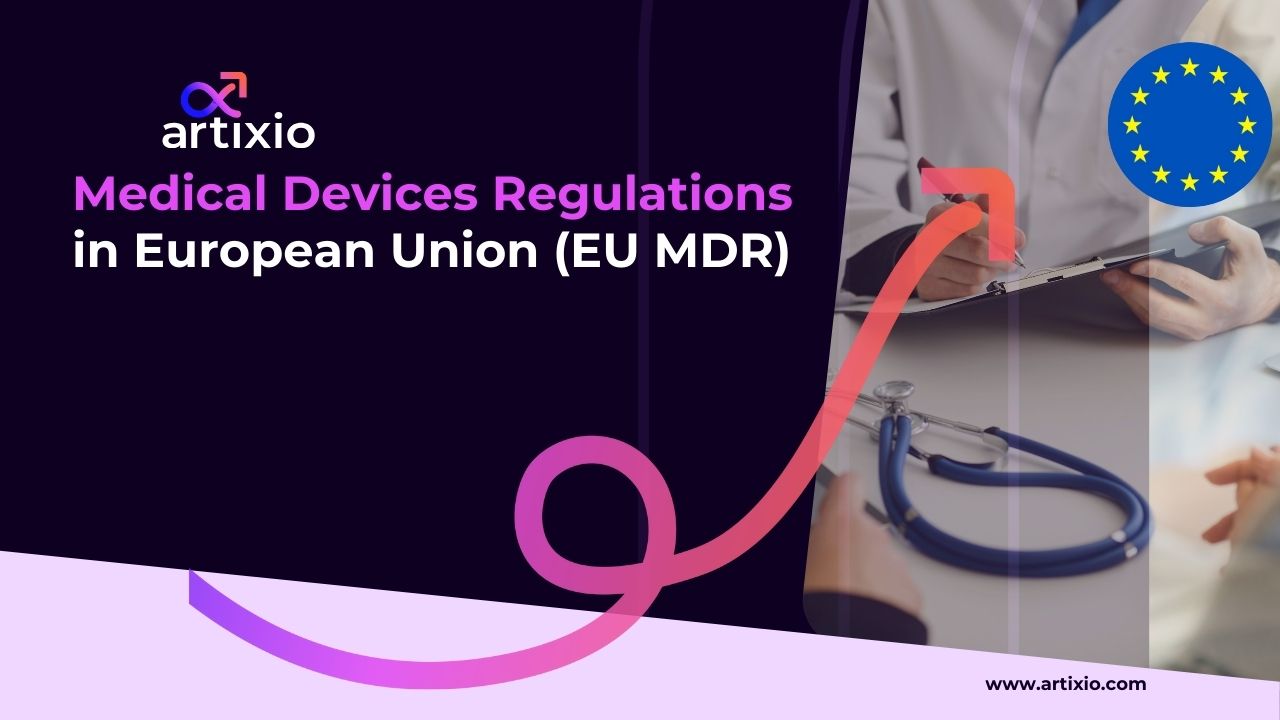The medical devices market in Europe has exhibited impressive value, surpassing USD 140.07 billion in 2022. Experts predict that this market will continue to experience substantial growth, with a projected compound annual growth rate (CAGR) of 4.09%. By the year 2027, the market is expected to reach an estimated value of around USD 171.19 billion. This robust expansion can be attributed to various factors fueling the demand for medical devices in Europe.
Advancements in technology, coupled with an expanding healthcare infrastructure, play a pivotal role in driving this growth. The European Union (EU) follows medical device regulations that safeguard patient health and provide a regulatory framework for manufacturers.
European Union EU MDR Medical Device Regulations:
In recent years, there has been a major overhaul of the regulatory framework governing medical devices in the EU. The previous directives have been replaced by the Medical Device Regulation (MDR) and In Vitro Diagnostic Regulation (IVDR) which seek to bolster patient safety and tighten the regulation of medical devices.
Legal Representation:
In order to comply with regulatory obligations, medical device and pharmaceutical companies originating from non-EU regions must designate a legal representative based within the European Union who will assume the responsibility of facilitating communication with relevant regulatory authorities.
Product Classification:
In the European Union, medical devices undergo a classification process to determine their level of risk. This classification, outlined in Annex VIII of the Medical Devices Regulation (MDR) 2017/745, divides them into four distinct classes. Let’s delve into each class and explore the types of devices that fall within them:
a. Class I – This class encompasses low-risk devices. Examples include everyday medical essentials like tongue depressors and bandages. These devices are considered to pose the least amount of risk to patients.
b. Class IIa – Devices in this class are classified as medium-risk. They include a range of medical devices such as hearing aids and infusion pumps. These devices have a slightly higher risk level than Class I devices but are still considered to be relatively safe for patient use.
c. Class IIb – In this class, we encounter devices that present a moderate to high level of risk. Examples include cardiac implants and X-ray machines. These devices require a greater degree of scrutiny and regulation due to the potential risks associated with their usage.
d. Class III – Finally, we arrive at the high-risk category. Class III devices pose the greatest level of risk to patients. This class includes devices like implantable pacemakers and heart valves, which are critical and complex in nature.
Labeling Requirements:
The MDR has established clear guidelines for labelling medical devices. Labels must include essential information like device identification, intended purpose, instructions, warnings, and manufacturer details.
Clinical Trial Requirements:
Medical device manufacturers are required to conduct clinical trials under the Clinical Trials Regulation (CTR) 536/2014. These trials are particularly important for high-risk devices, such as those in Class III, as they help demonstrate the safety and performance of these products.
Testing Requirements:
Medical devices undergo conformity assessment procedures, including testing, to ensure compliance with EU regulations. The specific testing requirements vary depending on the device’s classification and intended use.
Foreign Testing Applicability:
In the European Union (EU), testing data generated outside of the EU is generally accepted. This means that manufacturers can rely on testing done in other countries to demonstrate conformity with EU regulations. However, it is important to note that certain conditions and requirements must be met for this acceptance. The EU typically recognizes testing data from countries that have well-established regulatory bodies and mutual recognition agreements in place. These arrangements are aimed at ensuring consistent standards and the reliability of testing data for medical devices.
Pre-registration Requirements:
Manufacturers do not have to pre-register their medical devices with the European Medicines Agency (EMA) or other Competent Authorities. However, it is crucial for them to ensure that their devices comply with all relevant regulations before they can be placed on the market.
Registration Process:
In the European Union (EU), the conformity assessment process is applied to medical devices. This process consists of several steps to ensure compliance with regulations:
1. For higher-risk devices, a Notified Body must be designated.
2. Technical documentation and a Declaration of Conformity must be prepared.
3. The documentation is then submitted to the Notified Body for evaluation.
4. If the assessment is successful, the manufacturer is issued a Certificate of Conformity.
5. The device needs to be registered in EUDAMED, the EU database (when fully operational).
EU/US Approvals and Progressing Registration:
Obtaining approvals from the US FDA or other countries does not automatically guarantee approval in the European Union (EU). However, these approvals can provide valuable support by contributing to the necessary clinical and safety data required for EU registration. It is important to note that EU approval still follows a separate and distinct process.
Import and Distribution Requirements:
Manufacturers and distributors are obligated to adhere to import and distribution regulations. These include securing a valid CE marking for the device, maintaining accurate records, and promptly furnishing requested information to relevant authorities
List of Documents Required:
In regulatory compliance, there are several essential requirements manufacturers and distributors must fulfil.
a. Technical Documentation (Annex II, MDR): This includes comprehensive details about the device such as its description, design, manufacturing information, risk assessment, clinical evaluation, and labeling.
b. Declaration of Conformity (Annex IV, MDR): This is a declaration stating that the device fully complies with all the relevant regulations within the European Union.
c. Clinical Evaluation Report (CER): This report serves as crucial evidence demonstrating the device’s safety and performance, based on a thorough evaluation of the available clinical data.
GMP Inspection Requirements:
Authorities and notified bodies to perform Good Manufacturing Practices (GMP) inspections to ensure that manufacturers adhere to quality standards throughout a device’s lifespan. These inspections play a crucial role in verifying compliance with regulations, which in turn helps maintain consistent quality and safety standards for the benefit of end-users.
Timeline and Associated Fees:
In May 2024, all EC certificates issued or renewed within the past five years or four years from the MDR application date (May 27, 2020) will be valid. However, by May 2025, devices certified under the MDD will no longer be permitted for sale or distribution.
The European Medicines Agency (EMA) enforces fees for its services, which are regulated by the fee regulation (Council Regulation (EC) No 297/95) and its implementing rules. Moreover, the pharmacovigilance fee regulation (Regulation (EU) No 658/2014) oversees the fees associated with pharmacovigilance services provided by the agency.
Marketing Authorization Application: From €345,800
Extension of Marketing Authorization (Level I) and Type-II Variation: €103,800 each
Variations Requiring Assessment: From €8,600
Scientific Advice: From €51,800 to €103,800
Annual Fee (Level I): €123,900
Post-Marketing Activities:
Here are important aspects manufacturers need to consider for ensuring compliance with CE marking regulations:
a. Pharmacovigilance: To prioritize patient safety, manufacturers should establish a strong pharmacovigilance system. This system enables them to diligently monitor and report any adverse events linked to their devices.
b. Variations: Any modifications in a device’s design or intended use require careful assessment and approval from the Notified Body.
c. Renewal: Continuing to market devices within the European Union necessitates regular review and renewal of the CE marking. Manufacturers must proactively manage this process to avoid any interruptions in their device’s availability.
d. Audits: Competent Authorities have the authority to conduct post-market audits to assess ongoing compliance. Manufacturers should be prepared for such audits to demonstrate the continued adherence to regulatory requirements and facilitate the maintenance of market access.
CE Marking Process for Medical Devices in EU
The CE (Conformité Européenne) mark is a critical certification for medical devices seeking approval within the European Union. It signifies compliance with the EU Medical Device Regulation (MDR 2017/745) or In Vitro Diagnostic Regulation (IVDR 2017/746), depending on the type of device, and other applicable requirements. Obtaining the CE marking is a pivotal step for manufacturers aiming to distribute their medical devices within the EU. This blog will guide you through the complex process of achieving CE marking, which involves multiple pre and post-marking steps.
Step 1: Determine if Your Product is a Medical Device
Before delving into CE marking, it’s essential to confirm whether your product qualifies as a medical device under EU regulations. The definition of a medical device is comprehensive, encompassing a wide range of products. Ensuring your product falls within this definition is the initial crucial step.
Step 2: Determine the Classification of Your Medical Device
Device classification is a crucial step as it determines the regulatory pathway to follow. Classification depends on factors such as the device’s intended use, duration of use, potential harm to the human body, technical design, and manufacturing risks. EU classifies medical devices into four risk classes:
- Class I (Low risk)
- Class IIa (Moderate Risk)
- Class IIb (Moderate to High Risk)
- Class III (High risk)
Class I devices can further be classified as sterile (Class Is), with measuring function (Class Im), or surgically reusable (Class Ir). The complexity of the CE marking process increases as the risk class of your device rises, with different rules outlined in Annex VIII of the MDR.
Step 3: Appoint a Person Responsible for Regulatory Compliance (PRRC)
Each medical device manufacturer must designate a Person Responsible for Regulatory Compliance (PRRC). This individual should possess expertise in the field of medical devices and plays a pivotal role in ensuring ongoing compliance with EU regulations throughout the device’s lifecycle.
Step 4: Implement a Quality and Risk Management System
Developing a robust Quality and Risk Management System (QMS) is essential to meet safety and performance requirements. The QMS should encompass clinical evaluation, post-market surveillance (PMS), and post-market clinical follow-up (PMCF) plans. This system serves as the backbone of all compliance efforts. Notified bodies may issue either the EU QMS certificate or EU quality assurance certificate, depending on the conformity assessment procedure.
Step 5: Prepare Technical Documentation
Technical documentation is a critical component of the CE marking process, demonstrating compliance with General Safety and Performance Requirements (GSPRs) in Annex I of the MDR. This documentation should comprehensively describe the device’s design, function, testing, specifications, manufacturing processes, safety measures, and performance data.
Step 6: Manage Suppliers and Ensure Compliance
Effective supplier management is crucial for regulatory compliance. Maintain an approved supplier list and conduct necessary audits to ensure suppliers meet the standards outlined in regulations.
Step 7: Conduct a Clinical Evaluation
To assess the safety and effectiveness of your medical device, conduct a clinical evaluation. This involves gathering and analyzing clinical data from scientific literature and clinical investigations related to your device.
Step 8: Assign a European-Authorized Representative (EAR)
If you are located outside of the European Union, appoint a European-Authorized Representative (EAR) and obtain a Single Registration Number (SRN) from regulators via EUDAMED. This is particularly important for responsibilities like verifying technical documentation and addressing complaints.
Step 9: Certification from a Notified Body
For most devices (except Class I, non-sterile, and non-measuring devices), obtaining certification from a Notified Body is mandatory. Notified Bodies are independent third-party conformity assessment bodies designated by European national authorities. They review your quality management system and technical documentation to ensure compliance with MDR requirements.
Step 10: Obtain CE Certificate and ISO 13485 Certificates
Following a successful Notified Body audit, you will receive a Conformité Européenne (CE) marking certificate for your device and an ISO 13485 certificate for your facility. These certificates confirm your device’s compliance with EU regulations.
Step 11: Prepare a Declaration of Conformity (DoC)
With the certificates in hand, prepare a Declaration of Conformity (DoC) in accordance with Annex IV of the MDR. The DoC is a legally binding document that asserts your device’s compliance with European requirements, allowing you to affix the CE marking.
Step 12: Register Your Device with a Unique Identifier
For traceability, register your device under a unique identifier in the European Database on Medical Devices (EUDAMED) and assign a Unique Device Identifier (UDI) to your device.
Step 13: Affix the CE Marking
Display the CE marking on your device, packaging, and instructions for use, ensuring it’s clearly visible, readable, and durable. For Class II and III devices, include the identification number of the Notified Body alongside the CE marking.
Step 14: Implement Post-Market Surveillance
Set up a post-market monitoring system to oversee your device’s performance and safety once it’s available to the public. Consistently gather and assess data, handle complaints and incidents, revise safety reports, and ensure your documentation remains current.
Achieving CE marking for your medical device is a rigorous process that involves meticulous planning, documentation, and compliance with EU regulations. Understanding the risk classification of your device is key, as it determines the level of Notified Body involvement and the complexity of the conformity assessment. By diligently adhering to these steps, you can guarantee that your medical device aligns with the rigorous safety and performance criteria essential for a prosperous launch in the EU market. Remember, CE marking is not just a certification; it’s a commitment to patient safety and quality.
Conclusion:
In the European Union, the regulatory environment for medical devices is constantly evolving. Manufacturers need to stay updated and adhere to the Medical Device Regulation (MDR) and other applicable regulations to guarantee the safety and efficacy of their devices for patients in the EU market.
Ready to take the next step? Contact Artixio today to explore how our expertise can help you achieve your goals. Don’t miss out – let’s make it happen together!
References:
- European Commission – Medical devices: https://ec.europa.eu/growth/sectors/medical-devices_en
- Medical Device Regulation (MDR) – Regulation (EU) 2017/745: https://eur-lex.europa.eu/eli/reg/2017/745/oj
- In Vitro Diagnostic Regulation (IVDR) – Regulation (EU) 2017/746: https://eur-lex.europa.eu/eli/reg/2017/746/oj
- European Database on Medical Devices (EUDAMED): https://ec.europa.eu/health/md_eudamed_en
- European Medicines Agency – Medical Devices: https://www.ema.europa.eu/en/human-regulatory/overview/medical-devices




